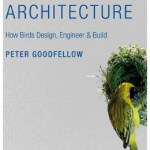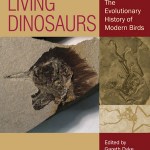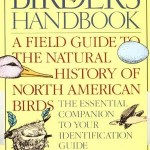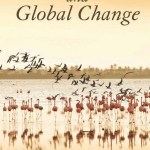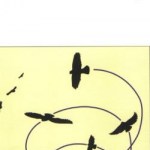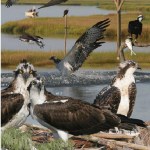Books-Birds
Birds don't live in nests. They make nests for specific purposes, use them for that purpose, then abandon them. Or, sometimes they don't abandon them, but rather add on and use them again and again, but in between they don't live in or on them. Well, sometimes they hang out on them a lot. And not all nests are for putting their eggs in. In fact, sometimes a nest is more of a symbol of quality and overall bird sexiness than it is a place to keep the chicks. As it were. Oh, and sometimes they live in the nests, now that I think about it ... It's complicated.
But there is a book that…
Here in the Northern Hemisphere, many of our birds fly away in the fall. Other, very cool birds from even farther north, depending on where you live then arrive. But just about now, where I live, we are at the tail end of the migration out and not quite at the migration in, so this is a good time to take stock of what is important: Which bird books do you want people to give you for Christmas?
Before I make any suggestions, I would like to point out that Princeton, an emerging and major player in the Bird Book world, has a facebook page that, if you "like," will automatically enter you in a…
Living Dinosaurs: The Evolutionary History of Modern Birds is an academic anthology of key writing about bird evolution. There are two main things that distinguish this book: 1) It includes quite a bit on fossils and their bearing on bird evolution, a refreshing change from DNA-based phylogenies which can by and large only address later questions of bird evolution; and 2) It includes a lot more about the early evolutionary context of birds (such as in the context of theropods) than one usually sees, rather than the diversification of birds per se, though it does address the latter as well.…
I've recently reviewed bird or nature books for some fairly exotic places (see this for all the reviews) including the Antarctic and the West Indies. Now, I have a book on the birds of one of the most exotic places ever: New Jersey!
OK, if you are from New York like I am, you know that was a joke. In all seriousness, New Jersey is an excellent place to go to see wildlife and I'm not talking about Atlantic City.
New Jersey has some of the largest swamps and marshes around, an extensive shoreline, and extensive pine barrens. Why, there are even mountains. The state, small and flattish…
I'm sitting here looking at Antarctic Wildlife: A Visitor's Guide. I've never been to the Antarctic so I can't tell you what I think of this book from the pragmatic angle of how well it works as a guide, but I can tell you that I've learned a number of things just looking at the book. For one thing, I had no idea that almost all tourist visits to Antarctica go to the same general area of the continent. I guess that makes sense given the geography of the region, but it had not occurred to me before.
I've guided a number of tours in Africa and some of my clients were very serious world…
The West Indies includes the Lucayan Archipelago (Bahamas and Turks and Caicos Islands); the Greater Antilles (Cuba, Hispaniola [Dominican Republic and Haiti], Jamaica, Cayman Islands); the Lesser Antilles (Leeward Islands [the Virgin Islands of Saint Croix, Saint Thomas, Saint John, Water Island, Tortola, Virgin Gorda, Anegada, Jost Van Dyke], Anguilla, Antigua and Barbuda, Antigua, Barbuda, Redonda, Saint Martin, Saba, Saint Eustatius, Saint Barthélemy, Saint Kitts and Nevis, Montserrat Guadeloupe); the Windward Islands (Dominica, Martinique, Saint Lucia, Saint Vincent and the Grenadines…
I recommend The Birder's Handbook: A Field Guide to the Natural History of North American Birds. It was written by three serious bird experts and it will serve any bird watcher in North America very well. Here's how you use it. You go bird watching and later, you look up one or two of the birds you saw, read the entries on them, read the entries cross referenced in those first entries, and otherwise explore around this compendium of information about bird ecology and biology.
The Book
For instance, you spy a Clapper Rail. So you look that up and see the reference to the essay on rails.…
I'm going to have more to say about this topic and this book at a later time, but I wanted to get a notice of it out for Migration Week. Bird Migration and Global Change by George W. Cox addresses the issue of impact on bird populations under conditions of global warming.
This is an authoritative and scholarly book that is totally accessible to the interested bird-oriented or climate/conservation-oriented audience. After several very important context and theory chapters, the author divides the world's migratory birds into major categories (such as "Northern Hemisphere Land Birds: Short…
As part of Migration Week (inspired by this post), I'm covering migration related books (mainly having to do with birds). How Birds Migrate by Paul Kerlinger (with Illustrations by Pat Archer), Second Edition, is an affordable, up to date (2009 publication) comprehensive and intelligently written book. It is written for the general public but is not dumbed down.
The thing about bird migration is that there are many facets to the behavior. There are different kinds of birds, with respect to the nature of their flight, body size, etc (think albatross vs. hummingbird). There are many kinds…
These are the kinds of books you get if you are either a scientists studying bird migration and related issues, or a very serious bird geek. The first two can be obtained at very low prices used, but the third will set you back at least 50 bucks US$ if you want a used copy. Note the spread of publication dates. It is not the case that the oldest book is out of date in all respects: Quite the contrary. Alerstam reviews theory and ideas that have not been revisited or revised to any great degree. Also, it is interesting to see how changes in the field develop over a decade or so. In any…
On the Wing: American Birds in Migration is a children's book suitable for up to Middle School or thereabouts. Remarkably, this ten year old volume is actually fairly accurate and comprehensible, covering most of the major aspects of bird migration, discussion ecological patterns, mechanisms, and methods used to study the phenomenon.
It is written and illustrated by Carol Lerner, who has prodcued well over a dozen anture related books of similar (high) quality including Butterflies in the Garden and Backyard Birds of Summer. Since these books are all at least ten years old you can find…
Description and identification of birds, or anything else, can be done in a rote manner with straightforward reference to details. If information about enough details is available, the identification will be accurate. But as humans we hardly ever do that sort of thing. If you ask someone to describe a car they saw recently, they will not refer to the angle of the back end or the overall dimensions or the specific layout of the headlights and tail lights. A person who does not know the make and model may say something like "It's a hatch back" or "It's an SUV" and in so doing provide…
Imma let you hear all about how Hawks at a Distance: Identification of Migrant Raptors is a remarkable and important field guide, but first I want to mention that one of the most interesting parts of that guide is the forward by Pete Dunne, who himself has written a bird book or two. Dunne reviews the history of bird identification guides, going back to the time before they actually included illustrations (yup, just words!) and follows the evolution of bird guides through the 20th century, with special reference to how raptors have been handled. Or, more exactly, mishandled.
It make sense…
Three days ago I happen to glance out the front window of our townhouse and found myself staring at a bald eagle swooping by, presumably after picking up one of the neighborhood dogs or small children1 A few minutes later, the doorbell rang. When I opened the door, no one was there but a package was on the stoep. And in the package was my new The Crossley ID Guide: Eastern Birds! It was almost a Harry Potter moment.
The Crossley ID Guide is a unique and special bird book. It is not exactly a pocket field guide, unless you are the Jolly Green Giant and have pockets the size of ... well,…
Galapagos Diary: A Complete Guide to the Archipelgo's Birdlife
... Continuing in our look at bird books to consider, I wanted to bring in the Galapagos Diary. I cannot tell you which is the best book for birding in the Galapagos, because, sadly, I've never done that myself. But my daughter, Julia, has, and she recommends this title. She brought a copy home from the Galapagos, and I am personally quite impressed by it. If you are planning a trip to the Galapagos, have a look at it.
~ A repost for Back to School Special ~
Bill Thompson's The Young Birder's Guide to Birds of North America is a book that I highly recommend for kids around seven to 14 years of age. (The publishers suggest a narrower age range but I respectfully disagree.)
This is a new offering written by Bill Thompson III and published by the same people who give us the Peterson Field Guide to the Birds and many other fine titles. The book includes excellent illustrations by Julie Zickefoose.
A birder since childhood, Thompson says he would have loved a book like this one when he was just getting interested in birds. Now a father of two,…
There are several characteristics that make up a field guide. It should be "pocket size" (and birders have huge pockets, so this may not be as much of a restriction as it sounds). It should cover the geographical region in which you are watching the birds, although in some remote areas of the world you may not have this luxury. During my years working in Zaire, we had only a Southern African bird guide, and made due. And the book should be of the right kind and level for your needs.
By level, I mean beginner or advanced. Sadly, most bird book publishers assume that there is a gene for…
previously reviewed
Birds: Nature's Magnificent Flying Machines is a book by Caroline Arnold and illustrated by Patricia Wynne for, I'd say, Pre-Elementary School kids and first/second grade. This is a good book to read to a pre-literate kid. Then put it away for later when the first grade academic report on birds is due ... it will be an excellent reference.
This is a well done and highly recommended book.
Birds... is highly specialized. It deals with only one topic: Bird flight. I like that. Who needs just another book on birds. Demonstrating to the little ones that there are…
As I write this, I am preparing for a trip up north. As we drive north we will follow the ecotone between the prairies and the deciduous woodlands, then track the ecotone between the prairies and the coniferous woodlands. Then we will make a turn and drive into the coniferous zone, cross the Mississippi, and then with a couple of small but palpable jumps in elevation and another hour and a half drive north, enter the lake region. Here, the primary vegetation cover certain times of the year is the nearly invisible diatom and algae layer on the top of the clear lakes, the bog plants, and the…
As long as we are on the subject (this week) of field guides, I thought I'd go ahead and suggest what guides you might take if you happen to be planning a trip to Central, East or southern Africa1
But since we are doing Africa, we need to do mammals as well as birds. But let's start with the birds.
The standard bird guide for southern Africa is Newman's Birds of Southern Africa and there was a time years ago that this was actually the best book for East and Central Africa as well, owing to a lack of other available field guides. Today, East Africa is well covered by the sometimes hard to…
